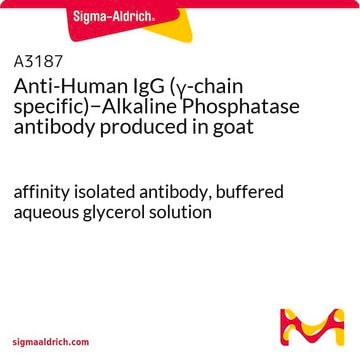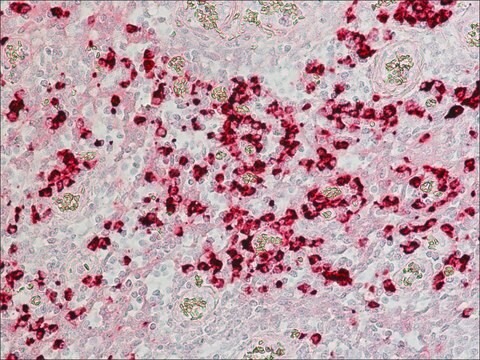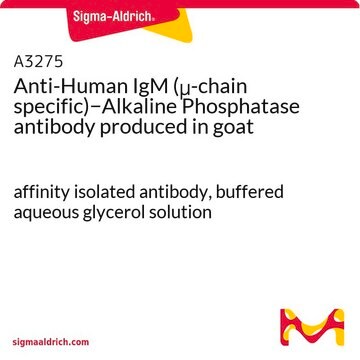A9544
Anti-Human IgG (Fc specific)−Alkaline Phosphatase antibody produced in goat
affinity isolated antibody, buffered aqueous solution
Synonym(s):
Anti Human Igg, Anti-Human IgG Antibody - Anti-Human IgG (Fc specific)-Alkaline Phosphatase antibody produced in goat, Anti-Human Igg, anti human IgG antibody
About This Item
Recommended Products
biological source
goat
conjugate
alkaline phosphatase conjugate
antibody form
affinity isolated antibody
antibody product type
secondary antibodies
clone
polyclonal
form
buffered aqueous solution
technique(s)
direct ELISA: 1:55,000
dot blot: 1:40,000 (chemiluminescent)
immunohistochemistry (formalin-fixed, paraffin-embedded sections): 1:150
shipped in
wet ice
storage temp.
2-8°C
target post-translational modification
unmodified
General description
Specificity
Binds human IgG; does not bind other human Igs.
Provides reduced background with mouse or rat samples.
Immunogen
Application
Anti-Human IgG (Fc specific)-Alkaline Phosphatase antibody has been used in
- quantitative sandwich ELISA
- α-GalC ELISA
- ELISA assays
- ELISAs for IgG subclasses
Biochem/physiol Actions
Physical form
Storage and Stability
Other Notes
Working dilutions should be determined by titration assay. Due to differences in assay systems, these titers may not reflect the user′s actual working dilution.
Disclaimer
Not finding the right product?
Try our Product Selector Tool.
Storage Class Code
12 - Non Combustible Liquids
WGK
WGK 1
Flash Point(F)
Not applicable
Flash Point(C)
Not applicable
Certificates of Analysis (COA)
Search for Certificates of Analysis (COA) by entering the products Lot/Batch Number. Lot and Batch Numbers can be found on a product’s label following the words ‘Lot’ or ‘Batch’.
Already Own This Product?
Find documentation for the products that you have recently purchased in the Document Library.
Customers Also Viewed
Our team of scientists has experience in all areas of research including Life Science, Material Science, Chemical Synthesis, Chromatography, Analytical and many others.
Contact Technical Service














